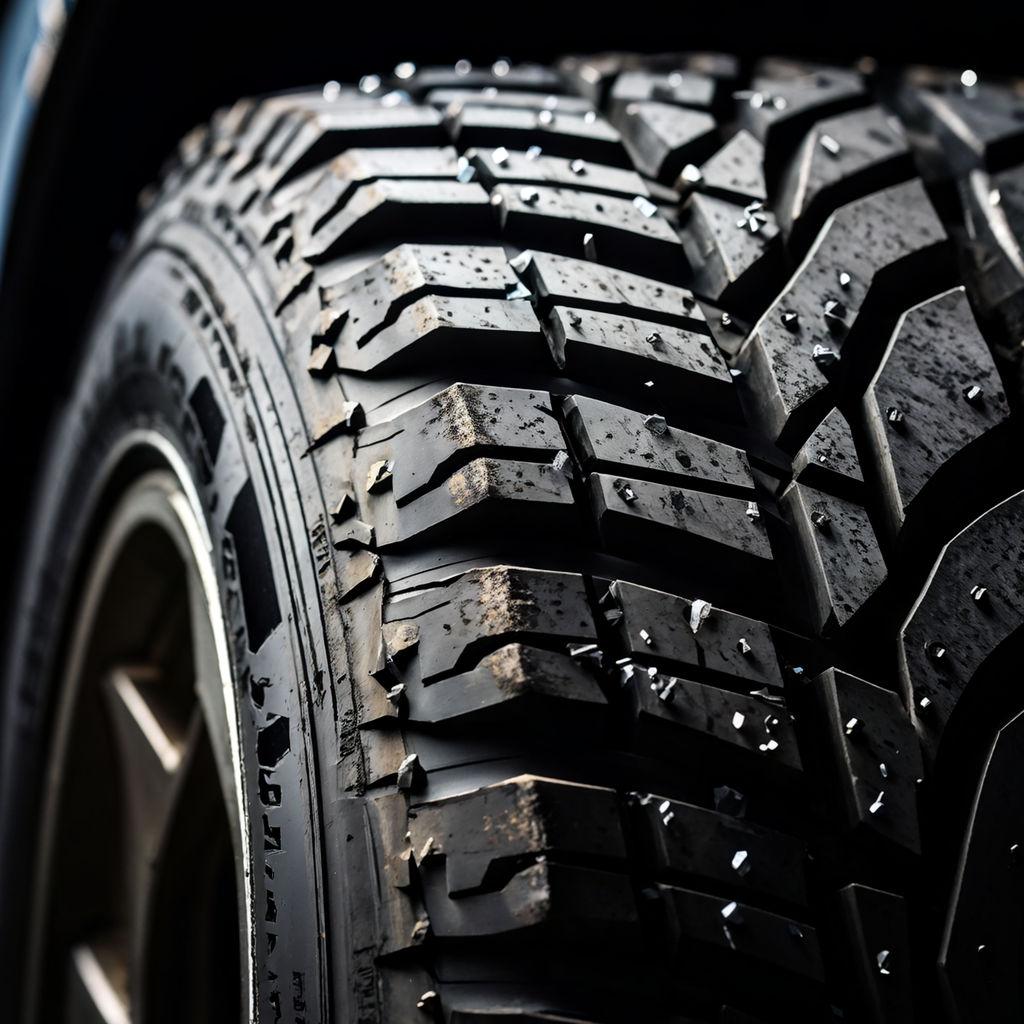- Key Takeaways
- Understanding Nail Damage in Tires
- Assessing the Safety of Driving with a Nail
- How Long Can You Drive with a Nail in Your Tire
- Checking for Tire Damage Yourself
- Repairing vs. Replacing Your Tire
- Patching a Tire with a Nail
- Scheduling a Repair Appointment
- Preventive Measures for Tire Care
- Summary
- Frequently Asked Questions
Did you know that approximately 60% of punctured tires are caused by nails? The good news is, when it comes to nails in tires, repairability is often an option. Understanding the process and knowing what to do can save you time and money. In this post, we will delve into how to determine if a tire with a nail can be repaired, the steps involved in fixing it, and when it’s best to seek professional help. Stay tuned to learn how you can address this common issue and get back on the road safely.

Key Takeaways
- Act Promptly: Address nail damage in tires promptly to prevent further harm and maintain safety.
- Regular Inspections: Regularly inspect your tires for any signs of damage, especially after encountering road debris.
- Consult a Professional: When in doubt about the safety of driving with a nail in your tire, seek advice from a professional.
- Consider Repair Options: Evaluate whether tire repair or replacement is the most suitable solution based on the extent of the damage.
- Prioritize Preventive Care: Implement preventive measures like proper tire maintenance and avoiding debris-laden roads to reduce the risk of nail-related tire issues.
- Safety First: Always prioritize safety when dealing with tire damage, and don’t hesitate to seek professional assistance if needed.
Understanding Nail Damage in Tires
Causes
Nails getting stuck in tires are often caused by construction sites, nail debris on roads, and DIY home projects. These common scenarios can lead to unexpected punctures.
Risks
Driving on a tire with a nail can result in gradual air loss, leading to reduced tire pressure. This can affect steering control and overall vehicle stability, increasing the risk of accidents.
Impact on Performance
Nails can compromise the tire’s structural integrity, causing uneven wear and reduced traction. This can significantly impact the tire’s durability and longevity.
Assessing the Safety of Driving with a Nail
Tire Condition
Driving with a nail in your tire poses serious safety concerns that can lead to potential accidents. The condition of the tire, including its pressure and overall health, significantly impacts the safety of continuing to drive.
It is essential to regularly check your tire pressure and inspect for any signs of damage, such as nails or punctures. Ignoring these issues can result in further damage and potentially endanger yourself and others on the road.
Distance Traveled
The distance you have already covered with a nail in your tire is another crucial factor to consider when assessing safety. Continuing to drive long distances with a nail can exacerbate the damage and increase the risk of a blowout.
If you have been driving with a nail in your tire for an extended period, it is advisable to stop immediately and evaluate the situation. The longer you drive with a nail, the higher the chances of causing irreparable harm to the tire.
Seeking Professional Help
When faced with a nail in your tire, it’s important to know when to seek professional help. While some minor punctures can be repaired, certain damages may require professional intervention to ensure the safety and longevity of the tire.
If you notice any signs of a nail in your tire, such as loss of pressure or unusual vibrations while driving, it is best to address the issue promptly. Delaying repairs can not only compromise your safety but also increase the risk of facing legal consequences if an accident occurs due to negligence.
How Long Can You Drive with a Nail in Your Tire
Severity Impact
A nail in your tire can be driven on for short distances if it’s located in the tread area. However, deeply embedded nails near the sidewall or shoulder are risky.
Driving Factors
Driving speed, tire pressure, and nail angle influence how long you can drive with a nail. High speeds and low pressure worsen the damage.
Consequences of Prolonged Driving
Driving with a nail can lead to a flat tire, loss of control, and even a blowout. It’s crucial to address the issue promptly.
Checking for Tire Damage Yourself
Visual Inspection
When it comes to tire damage, start by visually inspecting your tire for any punctures. Look closely at the tread and sidewalls for any foreign objects like nails or screws. These can cause slow leaks, leading to flat tires over time.
Perform a thorough check by running your hand along the tire’s surface to feel for any sharp objects embedded in the rubber. Even small nails can puncture the tire and cause air leakage. If you spot any damage, it’s crucial to address it promptly to prevent further issues.
Detecting Air Leakage
To determine if your tire has sustained damage from a nail, monitor the air pressure regularly. A gradual loss of air could indicate a puncture. Use a pressure gauge to measure the psi level in each tire, comparing it to the manufacturer’s recommended pressure.
If you suspect a nail is causing the leak, tow truck services may be necessary if the damage is severe. However, minor punctures from nails are often repairable with a tire plug or patch. Road hazard insurance can also help cover the costs associated with repairing or replacing a damaged tire.
Importance of Inspection
Regularly checking your tires for damage, especially caused by nails, is essential for maintaining road safety. Ignoring a nail in your tire can lead to a flat tire or even a blowout while driving, posing serious risks to you and other road users.
Repairing vs. Replacing Your Tire
Cost Consideration
Repairing a tire with a nail is generally more cost-effective than replacing the entire tire. Tire repair services are usually cheaper and quicker, making it a convenient option for minor damages. However, tire puncture repairs may not be possible if the damage is extensive or located in the sidewall.
While opting for a repair can save money in the short term, it’s essential to consider the long-term implications. A patched tire may have reduced durability and could be prone to future punctures. On the other hand, a new tire ensures optimal safety and performance on the road.
Safety Concerns
When deciding between repairing and replacing a tire with a nail, safety should be a top priority. A flat tire can significantly impact your vehicle’s handling and stability, especially at high speeds. A damaged tire, even if repaired, may compromise your safety on the road.
Tire sidewall repair is particularly crucial as any damage to this area can weaken the structural integrity of the tire. If the nail has penetrated the sidewall, replacement is often the only safe solution. Ignoring such damage could lead to a blowout while driving, posing a severe risk to you and other road users.
Long-Term Reliability
While repairing a tire may seem like a quick fix, it’s essential to assess its long-term reliability. Factors such as the age of the tire, tread depth, and overall condition play a significant role in determining whether repair is a viable option. A tire shop technician can provide expert advice on whether repairing the tire is a safe choice.
Replacing a damaged tire guarantees peace of mind and long-term reliability. New tires offer optimal traction, handling, and performance, ensuring that your vehicle operates efficiently in various road conditions. Having a spare tire in good condition is crucial for emergencies.
Patching a Tire with a Nail
Tools Needed
To patch a tire with a nail, you will require a tire repair kit that typically includes a reamer, plug insert tool, rubber cement, and tire plugs. These tools are essential for effectively sealing the puncture caused by the nail.
Patching Process
- Begin by locating the nail puncture on the tire. This can be identified by hissing sounds or visible damage.
- Use the reamer from the tire patch kit to clean and roughen the inside of the puncture hole for better adhesion.
- Insert a plug into the insertion tool, coat it with rubber cement, and push it firmly into the nail hole until only a small portion is left outside.
- Trim off any excess plug material flush with the tire surface using a knife or scissors.
Limitations and Considerations
- Pros: Patching is a cost-effective solution for minor tire punctures, extending the tire’s lifespan without the need for immediate replacement.
- Cons: However, patching may not be suitable for large punctures, especially those near the sidewall or if the hole exceeds a certain size.
Scheduling a Repair Appointment
Timely Action
Know when it’s time to schedule a professional repair appointment for a tire with a nail. Identifying the puncture early can prevent further tire damage. Ignoring the issue could lead to a flat tire or even more severe consequences.
Importance of Prompt Repairs
A quick response to a nail in your tire is crucial. Delaying repairs can worsen the situation, potentially causing a blowout while driving. Timely fixes not only ensure safety but also extend the lifespan of your tires.
Choosing the Right Service
Consider factors like convenience and expertise when selecting a repair service. Look for a provider that offers efficient solutions without compromising on quality. Ensure they have the necessary skills and tools to effectively patch the tire.
Preventive Measures for Tire Care
Regular Maintenance
Regularly inspecting your tires and ensuring they have proper tire pressure is crucial in preventing nails from puncturing them. Tires with low tire pressure are more susceptible to damage, so it’s essential to check and maintain the correct tire pressure recommended by the manufacturer. By doing this, you can significantly reduce the risk of encountering punctures while driving.
Maintaining the appropriate tire pressure not only enhances tire strength but also improves fuel efficiency. Many tire shops offer free tire pressure monitoring system checks, making it convenient for car owners to keep their tires properly inflated. Regularly inspecting the tread and outer tread grooves for any signs of wear can help identify potential issues before they escalate.
Using Tire Sealant
Consider using a tire sealant as an added layer of protection against punctures caused by nails or other sharp objects on the road. Tire sealants are designed to quickly seal small punctures, allowing you to continue driving without the need for immediate repairs. This temporary fix can be a lifesaver in situations where getting to a repair shop is not feasible.
One of the pros of using a tire sealant is its ease of use – simply inject it into the affected tire, and it will seal the puncture within minutes. However, it’s important to note that while tire sealants are effective in repairing minor punctures, they may not be suitable for larger or more severe damages. Therefore, it’s advisable to consult a professional if you encounter a significant nail puncture in your tire.
Safety Protocols and Road Hazard Protection
When driving, always be cautious of debris on the road that could potentially lead to nail punctures in your tires. Proper safety protocols such as avoiding potholes and debris-filled areas can significantly reduce the risk of encountering nail-related issues. Moreover, investing in a road hazard protection warranty for your tires can provide added peace of mind knowing that you’re covered in case of unexpected damages.
Summary
You’ve learned how nail damage in tires can impact your safety and the longevity of your tires. Assessing the risk of driving with a nail and understanding when to repair or replace your tire is crucial. By checking for damage yourself and knowing how to patch a tire, you can save time and money. Remember to schedule a repair appointment promptly if needed and implement preventive measures for tire care to avoid future issues. Taking these steps will keep you safe on the road and extend the life of your tires.
Ensure your safety by being proactive about tire maintenance and addressing nail damage promptly. Don’t wait until it’s too late—take action now to keep your tires in top condition!
Frequently Asked Questions
How can I tell if a nail in my tire is repairable?
If the nail puncture is within the tread area and less than 1/4 inch in diameter, it’s likely repairable. However, if the nail is close to the sidewall or there are multiple punctures, replacing the tire may be necessary for safety.
Can I drive with a nail in my tire?
Driving with a nail in your tire is risky as it can lead to sudden air loss or a blowout. It’s best to have the tire inspected and repaired promptly to avoid potential accidents on the road.
How long is it safe to drive with a nail in my tire?
It’s recommended not to drive more than 50 miles with a nail in your tire. Continuing to drive on a punctured tire can cause further damage and compromise your safety while on the road.
Is it possible to patch a tire with a nail?
Yes, tires with nail punctures can often be patched from the inside if the damage is within repairable limits. A professional technician can assess the extent of the damage and determine if patching is a viable solution.
What preventive measures can I take for tire care?
Regularly inspect your tires for any signs of damage, maintain proper tire pressure, avoid driving over debris, and ensure timely rotations and alignments. These practices can help prevent issues like nails puncturing your tires and extend their lifespan.

